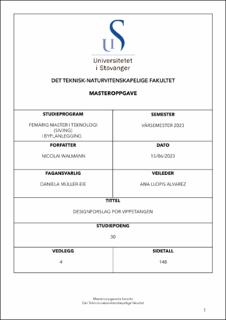| dc.description.abstract | Norsk:
Det har vært en betydelig endring i havnebyene etter tusenårsskiftet. I flere byer blir industrihavner nå omdannet til levedyktige distrikter som en del av transformasjonen. På grunn av begrensede areal-ressurser og økning i befolkning, må eksisterende byområder fortettes. Det er lagt et økende press på utviklingen av disse områdene på grunn av havnens attraktive lokasjon og begrensede arealer i byen.
Generelt ligger havner nær en kyst, elv eller innsjø, sentralt plassert, og er ofte knyttet til byens økonomiske utvikling og historie. Som et resultat er havnetransformasjoner utfordrende og komplekse. Flytting av havnefunksjoner og avindustrialisering har ført til en betydelig reduksjon i antall mennesker som bruker områdene, samt et økende antall av nedleggelser av forlatte industribygg, som har ført til tomme havneområder.
Med sine plasseringer mellom hav og land, er havneområder ypperlige steder for å skape gode bymiljøer. Dette er fordi de både er forbundet med havet og tilbyr et hyggelig sted for folk å bo. I moderne byutvikling har havneutvikling blitt en av de mest komplekse og viktigste oppgavene for utviklerne. Integrering av havnens arv og identitet er fortsatt en betydelig utfordring, men er viktig for å sikre at havnen opprettholder sin historiske identitet og karakter, samtidig som den implementerer en bærekraftig strategi som møter dagens retningslinjer.
Masteroppgaven min ser på området langs Vippetangen i Oslo sentrum i samsvar med Oslo
kommunes ønske om en omfattende havne-transformasjon. Denne transformasjonen kalles Fjordbyen, som strekker seg fra Sydhavna i sørøst til Frognerkilen i vest. Med Fjordbyen ønsker Oslo kommune å frigjøre dagens arealer ut mot sjøen og benytte disse til fremtidsrettet byutvikling med bolig, rekreasjon og næring på en slik måte at byen åpnes mot fjorden. En slik havnetransformasjon innebærer også å gjøre Vippetangen mer attraktiv (Oslo kommune).
Med disse forutsetningene som bakgrunn for oppgaven, ble problemstillingen som følger:
«Hvordan kan Vippetangen gå fra å være et industriområde til å bli et attraktivt oppholdssted med god tilknytning til vannet?»
For å svare på oppgaven vil det først bli gjort en teoretisk studie, etterfulgt av en analyse, samt en konsept utredning og designplan av området. Stedsanalysen av planområdet vil gi en bedre forståelse av områdets fordeler og ulemper, samt gir grunnlag for strategi og visjon som kan brukes i designfasen. Deretter kommer en utredning av visjonen og konseptet, med et designforslag for Vippetangen som skal vise til mine ideer og tanker bak forslaget.
Basert på funnene i analysen ble visjonen for Vippetangen:
«Attraktivt for alle, hele døgnet, gjennom hele året»
Det vil bli utarbeidet en rekke strategier for å nå visjonens mål, disse strategiene fører til det endelige designforslaget som jeg har kommet frem til. I siste kapittel diskuteres oppgaven, og det reflekteres over i hvilken grad problemstillingen er besvart.
Engelsk:
There has been a significant change in the port cities after the turn of the millennium. In several cities, industrial ports are now being transformed into viable districts as part of the transformation. Due to limited land resources and an increase in population, existing urban areas must be densified. Increasing pressure has been placed on the development of these areas due to the port's attractive location and limited areas in the city.
In general, ports are close to a coast, river or lake, centrally located, and are often linked to the city's economic development and history. As a result, port transformations are challenging and complex. Relocation of port functions and deindustrialisation has led to a significant reduction in the number of people using the areas, as well as an increasing number of closures of abandoned industrial buildings, which have led to empty port areas.
With their locations between sea and land, harbor areas are excellent places to create good urban environments. This is because they are both connected to the sea and offer a pleasant place for people to live. In modern urban development, port development has become one of the most complex and important tasks for developers. Integrating the port's heritage and identity remains a significant challenge, but is important to ensure that the port maintains its historical identity and character, while implementing a sustainable strategy that meets current guidelines.
My master's thesis looks at the area along the Vippetangen in central Oslo in accordance with Oslo
the municipality's desire for a comprehensive port transformation. This transformation is called Fjordbyen, which stretches from Sydhavna in the southeast to Frognerkilen in the west. With Fjordbyen, Oslo municipality wants to free up the current areas facing the sea and use these for future-oriented urban development with housing, recreation and industry in such a way that the city opens up to the fjord. Such a port transformation also means making Vippetangen more attractive (Oslo municipality).
With these assumptions as the background for the task, the problem was as follows:
"How can Vippetangen go from being an industrial area to becoming an attractive place to stay with a good connection to the water?"
To answer the task, a theoretical study will first be carried out, followed by an analysis, as well as a concept study and design plan of the area. The site analysis of the planning area will provide a better understanding of the area's advantages and disadvantages, as well as providing a basis for strategy and vision that can be used in the design phase. This is followed by an analysis of the vision and concept, with a design proposal for the Vippetangen that will show my ideas and thoughts behind the proposal.
Based on the findings of the analysis, the vision for Vippetangen was:
"Attractive for everyone, around the clock, throughout the year"
A number of strategies will be drawn up to achieve the goals of the vision, these strategies lead to the final design proposal that I have arrived at. In the last chapter, the thesis is discussed, and there is a reflection on the extent to which the problem has been answered. | |
